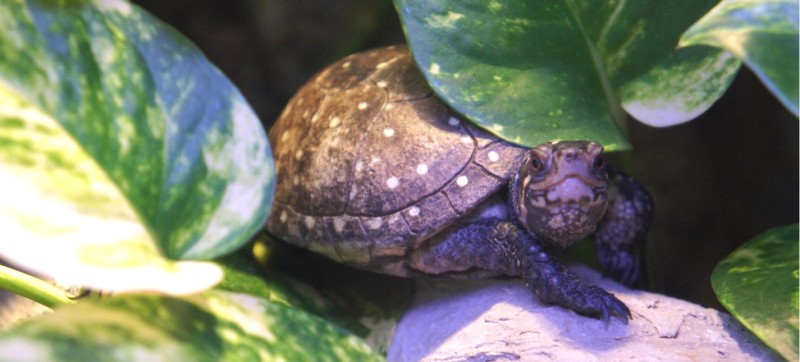Spotted Turtle - Clemmys guttata



Habitat:
Marshy meadows, bogs, swamps, ponds, ditches or other small bodies of water
Range:
Southern coast of Maine along east coast to Georgia. Also Southern Ontario west to Illinois
Activity Cycle:
Diurnal, most active from March to October and may be seen singly or in groups basking in the sun.
Features:
polka-dot turtle - has yellow spots on the head, neck, legs, and upper shell or carapace. Main body of turtles are black. Male turtles have dark pigment on the hard portions of both jaws; females have yellowish coloration on their jaws.
Size:
3 ½ to 5 inches
Social Structure:
Solitary
Life Expectancy:
average of 25-30 years. Some live up to 50 years
Diet:
Small animals, plants, and fruit.
Reproduction:
Females leave pools to dig nests in an open site (field, meadow, etc) digs hole and lays 3-6 eggs then covers the eggs and drags body over to smooth the dirt.
Status:
loss of habitat throughout its entire New York range. Pet collecting is currently responsible for annual loss of significant #’s. Listed as endangered and listed under Appendix II of CITES. It is also part of an AZA Species Survival Plan.
Interesting Facts:
- In the evening the spotted turtles submerge and spend the night on the pond bottom.
- When water temps cool to 32 degrees F, they will enter hibernation in Muskrat burrows or hangs out on the bottom of pools with flowing water.
- Has the ability to breathe through the skin when underwater.
- Sex of hatchlings is dependent on incubation temperatures with mostly females at the higher temperatures.

AZA cooperatively manages this species as a Species Survival Plan® Program.
Video:
Prices
- Adult (13 and over)$12.50
- Child (2 - 12)$9.00
- Child (1 and Under)FREE
- Senior (65+)$11.50
- Active Military$11.50
We begin transferring animals to evening (off exhibit) holding at 4:30 each night.
Find Us
2320 N. Prospect Rd.
Peoria, IL 61603
Phone: 309-686-3365
Open Daily 10:00-5:00
Last admission at 4:30
